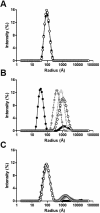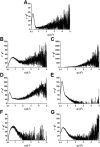The interaction of unfolding α-lactalbumin and malate dehydrogenase with the molecular chaperone αB-crystallin: a light and X-ray scattering investigation
- PMID: 21152271
- PMCID: PMC2998715
The interaction of unfolding α-lactalbumin and malate dehydrogenase with the molecular chaperone αB-crystallin: a light and X-ray scattering investigation
Abstract
Purpose: The molecular chaperone αB-crystallin is found in high concentrations in the lens and is present in all major body tissues. Its structure and the mechanism by which it protects its target protein from aggregating and precipitating are not known.
Methods: Dynamic light scattering and X-ray solution scattering techniques were used to investigate structural features of the αB-crystallin oligomer when complexed with target proteins under mild stress conditions, i.e., reduction of α-lactalbumin at 37 °C and malate dehydrogenase when heated at 42 °C. In this investigation, the size, shape and particle distribution of the complexes were determined in real-time following the induction of stress.
Results: Overall, it is observed that the mass distribution, hydrodynamic radius, and spherical shape of the αB-crystallin oligomer do not alter significantly when it complexes with its target protein.
Conclusions: The data are consistent with the target protein being located in the outer protein shell of the αB-crystallin oligomer where it is readily accessible for possible refolding via the action of other molecular chaperones.
Figures






Similar articles
-
R120G alphaB-crystallin promotes the unfolding of reduced alpha-lactalbumin and is inherently unstable.FEBS J. 2005 Feb;272(3):711-24. doi: 10.1111/j.1742-4658.2004.04507.x. FEBS J. 2005. PMID: 15670152
-
Mimicking phosphorylation of alphaB-crystallin affects its chaperone activity.Biochem J. 2007 Jan 1;401(1):129-41. doi: 10.1042/BJ20060981. Biochem J. 2007. PMID: 16928191 Free PMC article.
-
The small heat-shock protein αB-crystallin uses different mechanisms of chaperone action to prevent the amorphous versus fibrillar aggregation of α-lactalbumin.Biochem J. 2012 Dec 15;448(3):343-52. doi: 10.1042/BJ20121187. Biochem J. 2012. PMID: 23005341
-
Cell biological roles of αB-crystallin.Prog Biophys Mol Biol. 2014 Jul;115(1):3-10. doi: 10.1016/j.pbiomolbio.2014.02.005. Epub 2014 Feb 25. Prog Biophys Mol Biol. 2014. PMID: 24576798 Review.
-
Dynamical structure of αB-crystallin.Prog Biophys Mol Biol. 2014 Jul;115(1):11-20. doi: 10.1016/j.pbiomolbio.2014.03.003. Epub 2014 Mar 24. Prog Biophys Mol Biol. 2014. PMID: 24674783 Review.
Cited by
-
Chaperone activity of human small heat shock protein-GST fusion proteins.Cell Stress Chaperones. 2017 Jul;22(4):503-515. doi: 10.1007/s12192-017-0764-2. Epub 2017 Jan 27. Cell Stress Chaperones. 2017. PMID: 28130664 Free PMC article.
-
Co-fibrillogenesis of Wild-type and D76N β2-Microglobulin: THE CRUCIAL ROLE OF FIBRILLAR SEEDS.J Biol Chem. 2016 Apr 29;291(18):9678-89. doi: 10.1074/jbc.M116.720573. Epub 2016 Feb 26. J Biol Chem. 2016. PMID: 26921323 Free PMC article.
-
Quantification of anti-aggregation activity of chaperones: a test-system based on dithiothreitol-induced aggregation of bovine serum albumin.PLoS One. 2013 Sep 10;8(9):e74367. doi: 10.1371/journal.pone.0074367. eCollection 2013. PLoS One. 2013. PMID: 24058554 Free PMC article.
-
The chaperone αB-crystallin uses different interfaces to capture an amorphous and an amyloid client.Nat Struct Mol Biol. 2015 Nov;22(11):898-905. doi: 10.1038/nsmb.3108. Epub 2015 Oct 12. Nat Struct Mol Biol. 2015. PMID: 26458046
-
Impact of Salinity Stress on Antioxidant Enzyme Activity, Histopathology, and Gene Expression in the Hepatopancreas of the Oriental River Prawn, Macrobrachium nipponense.Animals (Basel). 2025 Aug 7;15(15):2319. doi: 10.3390/ani15152319. Animals (Basel). 2025. PMID: 40805105 Free PMC article.
References
-
- van Montfort RLM, Basha E, Friedrich KL, Slingsby C, Vierling E. Crystal structure and assembly of a eukaryotic small heat shock protein. Nat Struct Biol. 2001;8:1025–30. - PubMed
-
- Treweek TM, Morris AM, Carver JA. Intracellular protein unfolding and aggregation: The role of small heat-shock chaperone proteins. Aust J Chem. 2003;56:357–67.
-
- Horwitz J. Alpha-crystallin. Exp Eye Res. 2003;76:145–53. - PubMed
-
- Derham BK, Harding JJ. Alpha-crystallin as a molecular chaperone. Prog Retin Eye Res. 1999;18:463–509. - PubMed
-
- Carver JA, Rekas A, Thorn DC, Wilson MR. Small heat-shock proteins and clusterin: intra- and extracellular molecular chaperones with a common mechanism of action and function? IUBMB Life. 2003;55:661–8. - PubMed
Publication types
MeSH terms
Substances
LinkOut - more resources
Full Text Sources
Molecular Biology Databases
